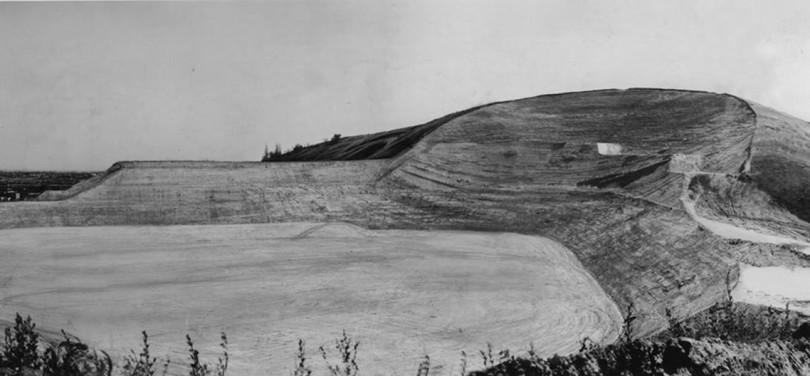
Reference Biography: Walter O’Malley
Construction of Dodger Stadium
In Los Angeles, the task of building a new stadium was no easy assignment. O’Malley worked hand in glove with the architects, engineers and the construction personnel over all aspects of 56,000-seat Dodger Stadium. He was concerned about the colors of the seats, the paint on the walls, parking issues, temperature of the hot dogs, landscaping, pitcher position in the bullpens, type of grass for the field, press box location, type of modern scoreboard, guard rail for parking lots, location of toll booths, ratio of male to female restrooms and cleaning operation. He meticulously built a stadium designed exclusively for baseball with unparalleled sightlines, which had been his goal all along.
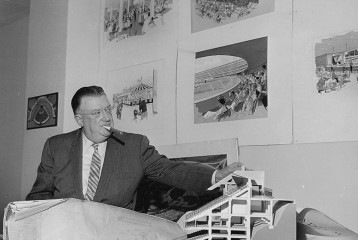
Walter O’Malley, surrounded by models, blueprints and artist sketches of the new Dodger Stadium. He was actively involved in each and every phase of the construction of his “dream” stadium.
Los Angeles Times Collection, UCLA Library Special Collections
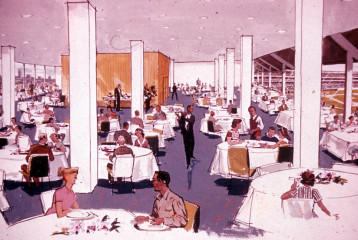
Members of the Stadium Club could watch the ballgame from either their box on the Club Level or within the confines of the elegant restaurant.
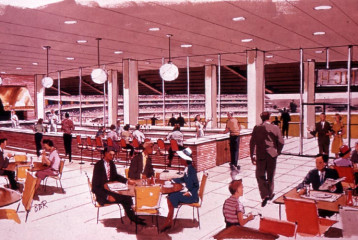
An artist’s rendering of the fine dining available for patrons of the new Stadium Club restaurant located on the Club Level at Dodger Stadium.
Every idea and suggestion was carefully reviewed for its merit by the detail-oriented O’Malley, who encouraged his staff and others to give input for the best stadium ever to be built. Some of the ideas that were considered included a monorail system; trams from the parking lot to the entrance gates; a milk and ice cream bar for kids; dancing, illuminated water fountains in center field; a chuck wagon restaurant; staff living quarters; an air-pumped flag pole to keep the flag waving; a zoo as part of the recreation area; a helipad; infrared heating near the seats; a bowling alley; moving sidewalk; sing along on the outfield message board; miniature golf course; and a large crossed bat with a ball on top monument at the Top of the Park parking lot.
The Vinnell Construction team moved eight million cubic yards of dirt and brought in 21,000 precast concrete units, some weighing up to 32 tons, to achieve this goal under the watchful eye of Dodger Vice President Dick Walsh and engineer Capt. Praeger of Praeger, Kavanagh and Waterbury of New York.
Then Dodger Vice President Fresco Thompson wrote: “To give you an idea of the vastness of the project, one might visualize a building whose walls encompass a city block of 400 feet by 200 feet. If a building of those dimensions, and 260 stories high (the Empire State Building is eighty-five stories high), could be erected and filled to the top, it would then hold the earth and rock which had to be moved to create the site for the Stadium.” Fresco Thompson book, “Every Diamond Doesn’t Sparkle,” ©1964
In describing some technical highlights about Dodger Stadium, a memo was sent to O’Malley by the designers and electrician and illuminating engineer J.S. Hamel of Los Angeles. Among the tidbits were that a “reflectorized” lamp was to be used for the first time in lighting and stadium history. A total of 1575 1200-watt lamps, each 10 inches in diameter totaling nearly two million watts and each lamp mounted in an optically precise reflector glare shield, directs the light rays to the playing field. This flood light is unique in that most of the massive glare of flood lights which shine in the spectators’ eyes will be eliminated by the “glare shield.” The lighting intensity on the playing field will be in excess of 200 foot candles, which will make Dodger Stadium the brightest and most uniformly lighted major baseball stadium in the U.S.A. More than 10 miles of steel and alluminium [sic] conduits carry a total in excess of 50 miles of insulated copper wires to supply power and miscellaneous electrical services to all parts of the stadium.”
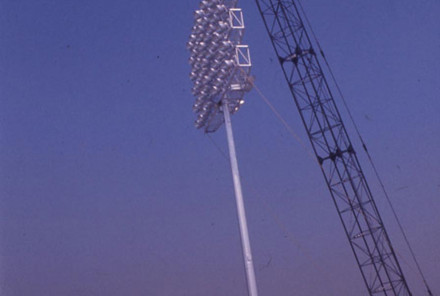
Installing the lights at Dodger Stadium.
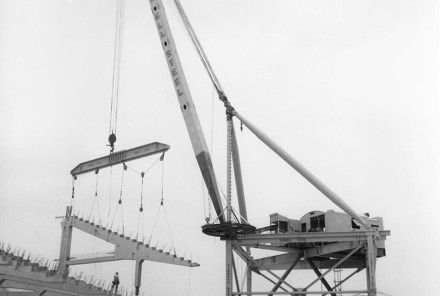
A special crane for the stadium was assembled by Vinnell Constructors.
Vinnell construction chief Yount, who meticulously oversaw every detail after the formal signing of the contract on August 25, 1960, recalled: “We didn’t get started until after Labor Day in 1960, so we had only 19 months to...get the place built. We had to have a crane about 120 feet high that would reach out 150 feet with a 40-ton load and set the load down like a feather. There were no cranes we could get hold of that would reach out that far with that load, so we built our own crane. After we were through, we tore it all up. It was the only job it was used on. It cost about $150,000.
“Since this was a controversial project, the city people wanted to make sure they kept their skirts clean,” Yount continued. “They made everything difficult for us. For instance, they made the Dodgers over design for earthquakes.
“There is a lot more strength in this stadium than there is in highway bridges. On this structure, we used almost seven sacks of cement a yard. On freeway bridges (which Yount built plenty of, including the 10 and 5 Freeway connectors in Los Angeles), they use five. For paving, they use four or less. So every yard of concrete poured at the stadium cost O’Malley about $1.50 extra just in cement alone. There are about 45,000 yards in the whole stadium.” Charles Maher, Los Angeles Times, April 8, 1971
The influence of Disneyland for its layout, parking facilities, trams and high level of customer service did not go unnoticed by O’Malley, who had his executives visit the Magic Kingdom in Anaheim and take notes. O’Malley had corresponded with Walt Disney and asked if he might have some suggestions as he built his new ballpark. Interestingly, Disney had rejected the idea of using the same unattractive Chavez Ravine land for a potential Disneyland site (quite possibly because of the massive amounts of earth that would have to be moved). Cary S. Henderson, Los Angeles and the Dodger War, 1957-62, Southern California Quarterly, Fall 1980, page 286
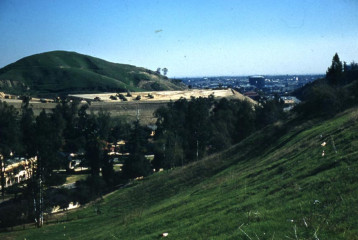
Chavez Ravine was a rugged terrain to level as eight million cubit yards of earth had to be removed for Dodger Stadium and its parking lots. At one time, the hilly land was considered by entertainment icon Walt Disney as he searched for a place for his “Magic Kingdom” but he rejected it.
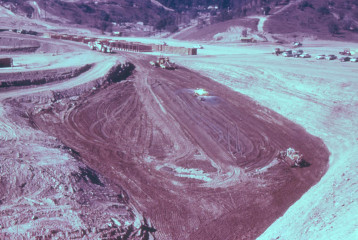
The hilly land required extensive grading and leveling, along with cement for the paving of service roads and parking lots.
Copyright © Los Angeles Dodgers, Inc.
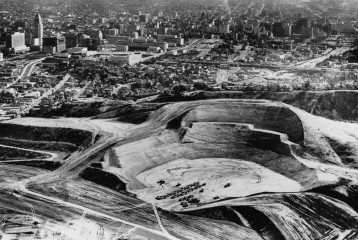
The construction area included making connections to the local freeway system already in place.
Dodger Stadium might have opened in 1961, instead of 1962, but court delays held back the construction process and prevented what might have been a move from the L.A. Memorial Coliseum a year earlier. Legal challenges to the passed 1958 Referendum took time to finally resolve, adding to the delay in building Dodger Stadium. The playing field and general construction took a beating with the inclement weather early in 1962, causing a frenetic pace to the last-minute work, but O’Malley vowed to play there as scheduled on April 10 no matter what.
In 1960, O’Malley assisted the efforts of famed singing cowboy Gene Autry to bring an expansion club, the Los Angeles Angels, into the American League, even though it meant the Dodgers would have to share valuable territory and compete for broadcast coverage. In their first season in 1961, the Angels played in Wrigley Field, once owned by O’Malley but had reverted back to the city as part of the contract with the Dodgers. Originally, Autry’s radio station, KMPC 710 held the radio rights to Dodger games, but the Dodgers shifted to the more powerful 50,000-watt clear-channel KFI for the 1960 season. Dodger games could be heard in many states and as far away as Hawaii on KFI AM 640.
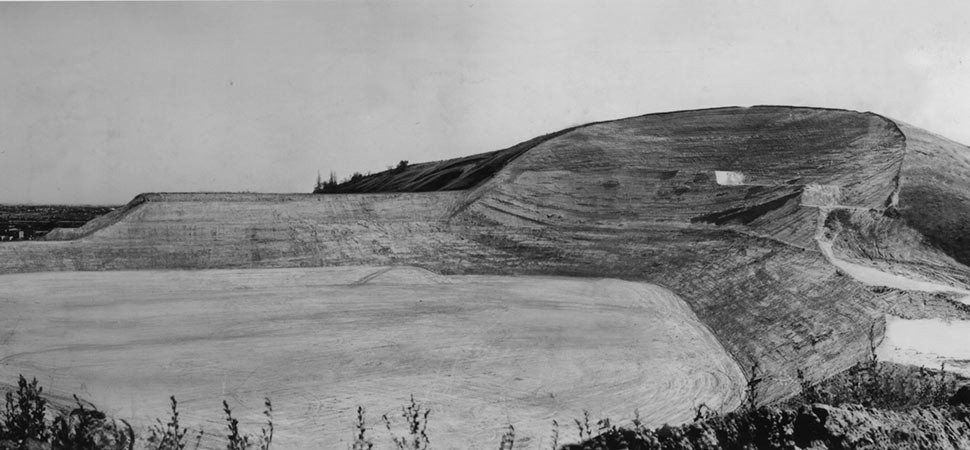
By cutting into the land, Dodger Stadium designers took advantage of this setting for the ballpark seating and elevated parking levels.
Courtesy of University of Southern California, on behalf of the USC Specialized Libraries and Archival Collections
Autry credited O’Malley with his support and a place to play beginning in 1962, where the Angels shared new Dodger Stadium for four seasons. “It was only because of his help that we were able to bring an American League team to L.A.,” said Autry. “The Angels have a tough row to hoe.” Bud Furillo’s Steam Room, Los Angeles Herald & Express, April 27, 1961
In February 1962, O’Malley had incurred a $500,000 overage because of the deluge as construction was halted. Without question, he wanted an April opening. Under the heading of “Touching All the Bases,” he even made an inquiry to Angels’ owner Autry about temporarily playing games at Wrigley Field.
O’Malley vowed, “I’m a stubborn man. We will hit the target date, no matter what the weather.” The paving was 90 percent completed at that time. He continued, “Actually, I guess all we’ve lost is time, money and some top soil. And, I may have to chase that top soil down to the Los Angeles River.” Bob Hunter, Herald Examiner, February 11, 1962 That month, a heavy “jet engine drying machine was brought onto the field in order to get the turf ready for sodding. Blasts carried as far as 300 feet.” Photo Caption, Los Angeles Times, February 23, 1962 But, the timing of the stadium’s opening was almost perfect.
The grass did not look like what O’Malley expected for the unveiling of the ballpark. His friend and studio producer Mervyn LeRoy gave him an answer — dye the grass green (the color of spinach) just like in Hollywood. That is what the Dodgers did and it worked to perfection, short of a few green paint-stained pant legs from the players!
A nervous O’Malley wrote a Western Union telegram to American Seating Company, who was the only sub-contractor unaffiliated with Vinnell Constructors, which had the task of putting in all of Dodger Stadium’s seats. On April 2, just days before the first game, O’Malley wrote, “Engineer, General Contractor and Owner shocked at lack of progress by your workmen at this late date. We want your work finished by Wednesday midnight and your people off the premises so we can wash down and clean the stands and get the house in order. You might have had an excuse for parts delayed in arrival but you have no excuse for not setting in final condition those parts already on the job.”
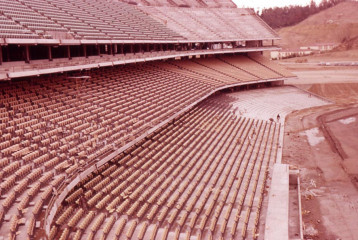
Heavy rains in Southern California in February 1962 made the construction project a challenge as top soil on the playing field washed away, causing delays and additional costs.
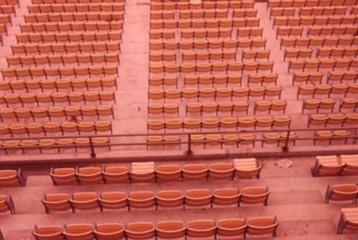
The American Seating Company was the only subcontractor unaffiliated with Vinnell Construction. If placed side by side, the multi-colored seats would form a continuous row of more than 33 miles long.
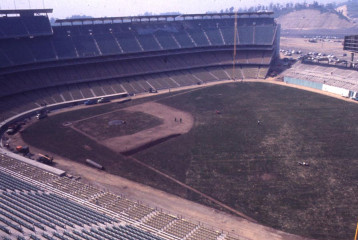
Walter O’Malley’s target date for the opening of Dodger Stadium was April 10, 1962.
The seats selected by the Dodgers were theatre-style, up to 22 inches wide with arm rests between each seat. The back and seats are steam-bent hardwood and the standards were made of cast gray iron. Approximately, three tons of aluminum nuts and bolts were used in the seat construction. If placed side by side, the multi-colored seats would form a continuous row of more than 33 miles long, from Los Angeles to Pomona.

